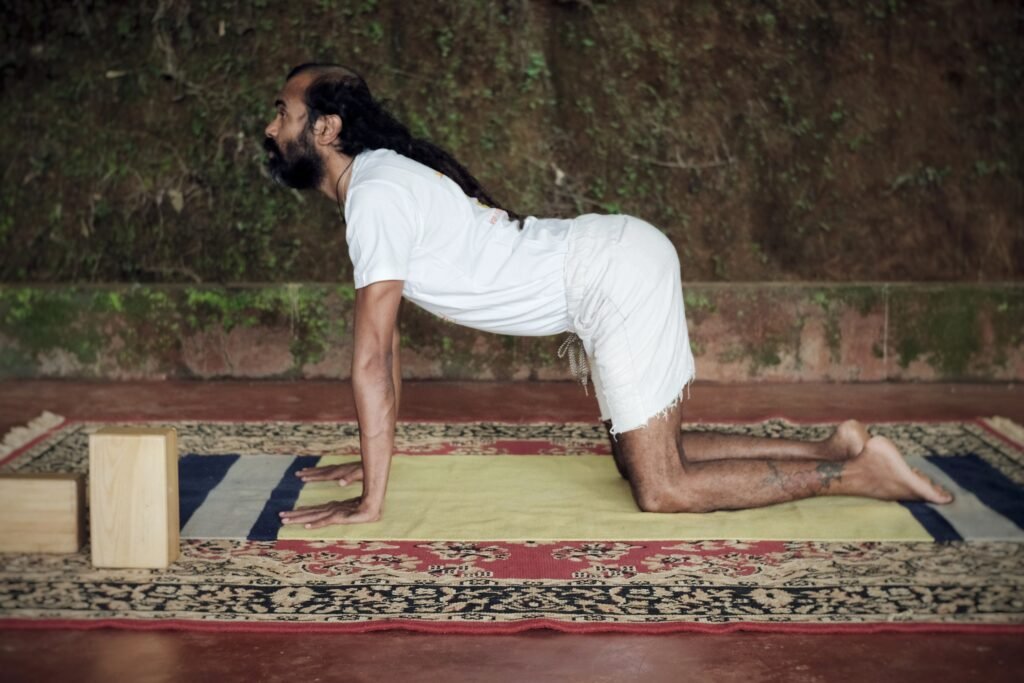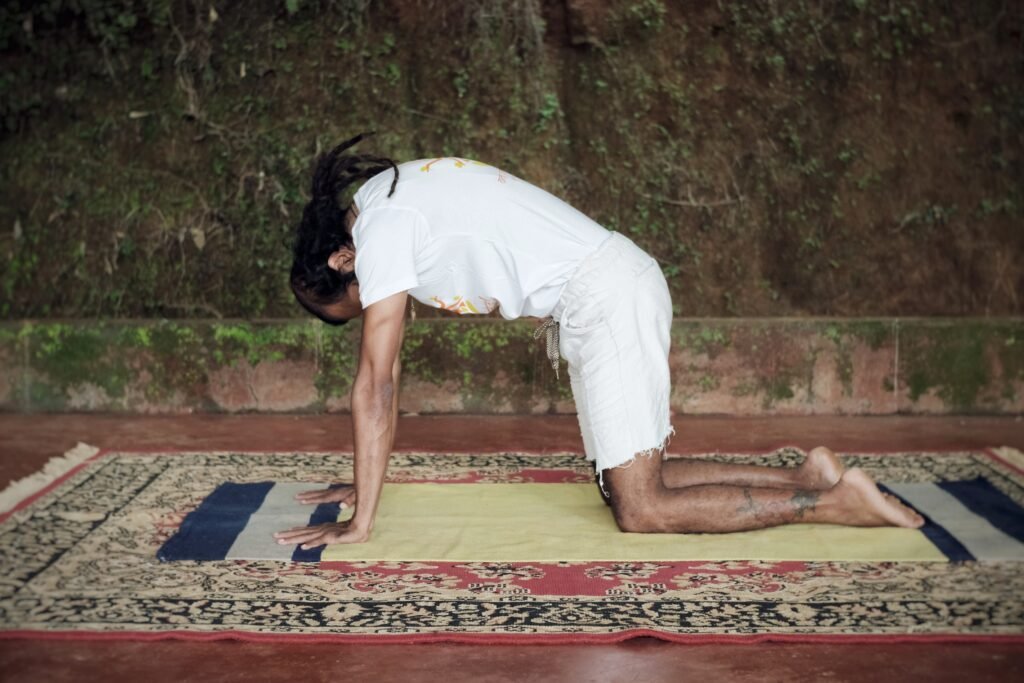
“Bitila” translates to “Cow” when translated from Sanskrit.Bitilasana, also known as Cow Pose, is typically performed dynamically while in Cat Pose. The body movement here resembles the Cat and the Cow, which occurs when the exercise is performed dynamically.
The intense stretch is similar to that of a Cat, and the relaxed condition is similar to that of a Cow. This is where the moniker “Cat-Cow Pose” originates from.
Because more of the movement is done with the spine (a combination of two movements), this enhances the spine’s flexibility, increasing the flow of prana.
STEPS FOR BITILASANA:
- Start with table pose, on your hands and knees, maintaining a neutral spine position.
- While moving into cow pose, inhale deeply and push your sit bones toward the ceiling. At the same time, squeeze your chest forward and allow your belly to sink.
- Raise your chin, roll your shoulders back and away from your ears, and fix your sight on what’s in front of you.
- Come into cat pose by exhaling and curving your spine outward, tucking in your tailbone, and drawing your pubic bone forward. Do this while drawing your pubic bone forward.
- Let your head fall toward the floor, but avoid bringing your chin into your chest as you do so. First and foremost, try to calm down.

Advantages of the Cat-Cow Pose:
Stretches, Strengthens, and Lengthens:
Cat Cow Pose does a beautiful job of strengthening the back and spine. When you stretch like a cow, you engage the tailbone, the spine’s starting point. On the other hand, the cat stretch helps release tension in the upper back and neck. The back, abdomen, hips, lungs, and chest can all benefit from some stretching with the cat and cow exercise.
Because of this, the circulation of blood in the spine and the pelvic region is improved.
Through consistent practice, this posture helps free up the tight muscles around the shoulders, gradually develops the strength of the hands and wrists, and prepares the students for the Downward Dog Pose.
Flexibility and Range of Motion:
Cat Cow Pose is excellent for increasing neck, shoulders, and spine flexibility and extends the range of motion in these areas.
When activated, the tailbone emphasizes the root movement of the spine, which in turn promotes the flexibility of both forward and backward bends. This pose helps to promote flexibility in the spine, which maintains the healthy gap between each vertebrae.
Chest, Diaphragm, and Breath:
The spine’s mobility is so fundamental to the Cat-Cow Pose that novices frequently forget about another vital part: breathing. Chest, Diaphragm, and Breath: The Cat-Cow Pose stretches the chest, the diaphragm, and the breath. When attempting Cat-Cow Pose, it is essential to lift the chest by moving the shoulders away from the ears to create space between them.
The diaphragm can be improved by taking longer, slower breaths and expanding the chest more. This exercise involves taking long, slow breaths to stretch out the diaphragm, which, in turn, leads to the expansion of the chest cavity. This, in turn, contributes to the healthy operation of the heart and lungs.
Awareness and Concentration:
Cat Cow is an exercise that helps trainees develop their awareness of their breathing since it requires them to move in time with their breath.
Therefore, the trainees ought to be instructed and made to comprehend that the objective is not just to perform the spinal movement but to entirely submit to their breath because this assists in nourishing the body.
The practitioner gains a greater sense of what it is like to be alive as a result of using the breath to guide the movement.
When attempting to perfect this pose, it is important to keep a keen awareness of the location of the pelvis.
The students will be better able to become aware of the location of their pelvis in every asana they practice as a result of this.
The energy that courses through the body is distributed most prominently down the spine.
Gaining an awareness of the body’s core can be facilitated by focusing on the spine and seeing how the back movement corresponds with the breath.
Because of this, holding this asana helps to realign the body, producing toned arms and legs and a body posture that exudes self-assurance and strength.
Stimulation of Organs and Systems, and Circulation:
This exercise stimulates the glands of the abdominal region, such as the kidneys, the liver, and other organs, due to the expansion and contraction of the abdomen. It performs a light massage on the abdominal organs, which results in enhanced digestion and metabolism, as well as the maintenance of overall good health.
In addition, it strengthens the female reproductive system, which is why it is beneficial for women who experience monthly problems to engage in this activity.
Cow Pose helps maintain a healthy level of thyroxine (a hormone that regulates digestion, heart and muscle function, brain development, and bone maintenance) in the body by slightly bending the back and elongating the neck to look upwards. This stimulates the thyroid glands, which in turn helps maintain a healthy level of thyroxine.
Energizing, De-stressing, and Relaxing:
All of the asanas that focus on the spine are very energetic. The tense muscles in the upper, middle, and lower back are relaxed, which increases the flow of energy. Additionally, by releasing pelvic rigidity, this pose helps reduce stress in the lower back and hips.
Because of the emphasis placed on the breath in the Cat-Cow Pose, the practitioner can achieve a state of mental tranquility and relaxation.
Reducing the stiffness in the spine and soothing the nerves contribute to activating the parasympathetic nervous system, which is why regular spinal movement benefits its health.
Ailments, Healing, and Therapeutic Benefits:
Menstrual cramps and suffering can be alleviated by coordinating your breath with the Cat-Cow Pose. As a result of its toning effect on women’s reproductive organs, it is often included in prenatal yoga.
However, if you are pregnant, you should try to avoid doing any poses that cause you to have forceful abdominal contractions.
People who lead sedentary lives are at risk of developing health problems such as a slower metabolism, obstructed blood flow, back discomfort, and other similar symptoms.
In the “Cat” stance, the back is stretched to its fullest, and the spine is opened. The discomfort caused by sciatica may be alleviated as a result of this.
Balance and Emotions:
Cat Cow Pose is a relaxing and letting-go pose that helps balance and emotional stability. Because the entire spine is stretched, a healthy flow of prana is encouraged from the tailbone up to the top of the head, increasing the amount of energy sent toward the brain.
As a result, those who suffer from headaches and lack of sleep might reap the benefits of striking this stance. As a result, the practitioner experiences improvements in their mental and emotional state.
The Solar Plexus Chakra, the Swadhisthana Chakra, and the Root Chakra are primarily stimulated by Cat Cow. By opening the flow of energy through Sacral Chakra, this position can assist in emotionally releasing feelings such as resentment, shame, and an obsessive urge.
The exercise fosters creativity and the capacity to concentrate, learn, and experience feelings that are both vital and significant.
Contraindications for the Cat-Cow Pose (Bitilasana Marjaryasana):
Injuries and Surgeries:
People with injuries in the shoulders, neck, knees, or back should be cautious while doing the pose, or they should avoid doing the practice altogether because it can make the problem worse. People who have had surgery on their abdomen or spinal column should steer clear of this stance. Students experiencing pain or inflammation in their knees or hips due to participating in this practice should not do so.
Weak Body:
If any of the pupils feel stains, particularly in the lower back, make sure that they are taken care of and urge the kids not to proceed any further than that point. Students should make every effort to keep a range of motion that is not accompanied by discomfort. Therefore, students need to have this awareness, as it will allow them to avoid harm by listening to their bodies and avoiding overexertion. When kneeling, persons who are overweight need to be more careful.
Others:
Some persons will have a great deal of discomfort if they remain on their knees for an extended period. In this scenario, yoga instructors might utilize yoga props such as yoga knee pads and blankets to provide better cushioning for their students.When holding this posture, pregnant women should keep their bellies up and always work under the guidance of an experienced yoga instructor.
